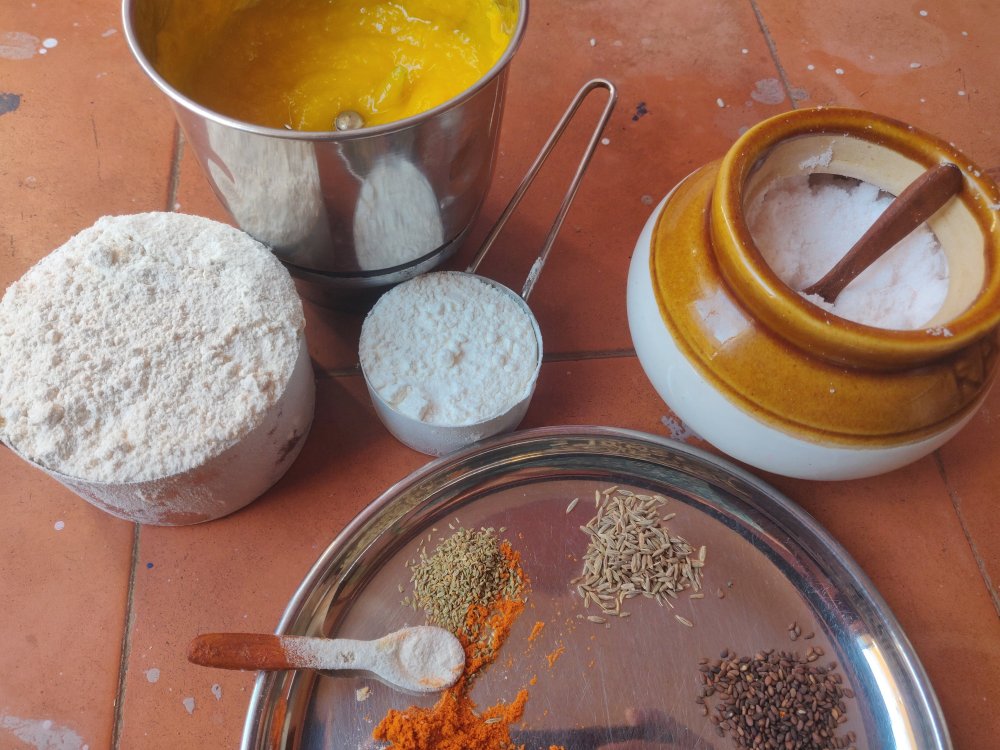We recently had a bumper harvest of 50 kgs of pumpkins. Pumpkins can be stored for as long as six months after harvest. If you notice the local vegetable shops, they usually keep full pumpkins in shelves and cut them open only when people ask for it.

We have decided to store most for ourselves, share a few with friends and family and sell the remaining. Other than the usually stir fry and curries made with pumpkin, I wanted to make something different with it. When I asked people to give me some interesting recipes to cook with, Niranjan shared the recipe for ‘gharge’, a Maharashtrian pumpkin poori. I got super excited, noted down the recipe and decided to make them during weekend. We paired it with usual potato masala that is served with pooris in several south Indian states.
Ingredients
- 1 cup wheat flour
- 1/4 cup rice flour (use fine flour, since we are going to make pooris)
- 1 cup cubed pumpkin, cooked and puréed
- 1 tsp sesame
- 1tsp carom
- 1 tsp cumin
- 1 tsp chilli powder
- A pinch of asafoetida
- Salt, to taste
- Oil for frying
Method
- Pressure cook pumpkin pieces for two whistles in a cooker or boil it in stove top with little water. Drain and blend it smooth in a mixie without water.
- Take all the dry ingredients in a wide bowl

- Add pumpkin puree to it and knead to form a soft dough. I didn’t add any water to make the dough as the puree had enough moisture. Add more wheat flour if the dough is wet.

- Let the dough rest for half an hour.
- Take oil in a kadai and heat it on stove
- Make small balls of the dough and roll them into even discs
- Once the oil starts smoking, put one poori and gently sink it into the oil with the back of a ladle. The poori will puff up and float.

- Turn the poori and let it cook for few seconds and remove it from oil.

- Cook the remaining pooris the same way and serve them hot 🙂

I am sure there are several ways Maharashtrians make this poori. If you make it in a different way, share your recipe with me, I’d love to try it out!We also make a Tirunelveli famous mixed vegetable kuzhambu with yellow pumpkin as main vegetable. I will share that recipe in the coming week. If you like the blog, please share it with your friends and family.
How we cultivated the pumpkins
It took minimal effort to cultivate them especially because of volunteers Akshat and Vita. They built us an amazing keyhole garden of 6 ft diameter in the last week of June last year. It had 3 components to it :
- the structure of stones which gives the garden a height so that it is easy for senior citizens to access it
- the layers of soil and organic & nitrogenous matter
- the central accessible composting chamber to add kitchen waste
The contents of the garden were top soil, cow dung, lots of organic matter such as: sesame crop waste, coconut leaves, hay, neem leaves. These were done in layers and watered to accelerate decomposition.
We then sowed yellow pumpkin, white pumpkins, cucumber, broad beans (avarakkai) and cluster beans (kothavarangai). We didn’t intend to monocrop the keyhole garden. But the yellow pumpkin creepers just took over. The only other harvest from the keyhole garden other than this yellow pumpkin was 1 small white Pumpkin and a few broad beans. The yellow pumpkin seeds were native seeds whereas the white pumpkin ones were hybrid. We got better results from native seeds and therefore we are going to pursue them as much as possible. In 5 months, 6 seeds produced these beautiful looking pumpkins for us.
We sowed seeds in the month of August. The total area the creepers took over must have been around 80 ft by 80 ft i. e. 6400 sq ft ~ 15% of an acre. This sells at Rs. 60 per kg locally during Pongal and at Rs. 20 per kg in the rest of the year. The cash flow to grow this crop was almost zero – All the material was available at the farm. 🙂